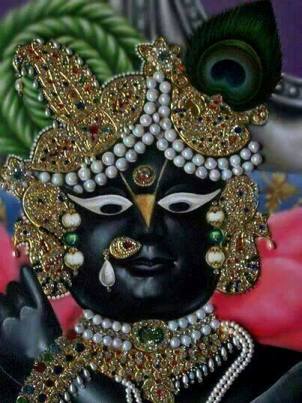Nathdwara literally means 'the Gate of the Lord'. The city is located on the banks of the Banas River and is home to one of the most popular pilgrimage destinations in the country – the temple of Shrinathji, dedicated to Lord Krishna. The temple has a rich cultural and historical legacy as it is associated with many legends of the Lord. The temple attracts pilgrims from all across the globe and is one of the wealthiest temples in the country. The temple is held in high reverence by the  Pusthtimarg sect of Vaishnavism and has been referred to at various periods in history as Srinathji Dwar, Shriji Dwar, Shri Nathdwara. The Lord's image, a Swayambhu or naturally formed image, in the Sanctum is a visual delight and is decorated with brilliant Zari weaves. Traditional worship services like Aarthi and devotional songs are performed regularly. Nathdwara is also popular for the beautiful 'Picchavai' paintings known for their artistic depictions of legends related to Lord Krishna.
Pusthtimarg sect of Vaishnavism and has been referred to at various periods in history as Srinathji Dwar, Shriji Dwar, Shri Nathdwara. The Lord's image, a Swayambhu or naturally formed image, in the Sanctum is a visual delight and is decorated with brilliant Zari weaves. Traditional worship services like Aarthi and devotional songs are performed regularly. Nathdwara is also popular for the beautiful 'Picchavai' paintings known for their artistic depictions of legends related to Lord Krishna.
History
The history of the temple is actually intertwined with several popular legends. Sri Vallabacharya, the great saint and the founder of the Pushtimarg sect of Vaishnavism, is associated with the legend of Lord Shrinathji and with the help of his disciples erected a beautiful temple on top of the Govardhan hills. The area is also known as 'Vraj Bhoomi' from the legend of the Lord's sacred cows, which used to graze here. Over the centuries, the temple became the cynosure of Bakthi tradition. The Lord's image had to be transferred from Govardhan hills as a safeguard from the attacks of the fundamentalist moghul emperor Aurangazeb back in the seventeenth century CE. However, the image was consecrated at the present place owing to a legend. The temple was once a royal palace of the rulers of the Mewar region (the Sesodia Rajputs) and fell under the attack of the Holkar Marathas in 1734 CE.
Legends
The image of Lord Shrinathji had to be shifted from Govardhan hills as a safeguard from the attacks of Aurangazeb. During the journey, the wheels of the cart carrying the Lord's image got struck in mud and couldn't be moved any further. The accompanying priest realized this as a 'leela' of the Lord and interpreted this as the 'chosen place'. A temple was thus erected at this very spot.
There are many popular legends associated with the temple besides the above and according to one of the legends, a cow from a local herd used to climb to the top of the Govardhan Hill and perform 'Abhishek' by discharging her milk on a mysterious black arm. The cowherd couldn't understand the reason behind the cow's reduced milk output and was astonished to find out the reason after following the cow to the hill one day. Soon, the news spread out and the locals flocked to the sacred spot. People began to worship the Lord with great reverence as the Lord fulfilled all their desires.
Festivals
Janmashtami, the birthday of the Lord, is celebrated with great religious fervor. People from all across throng the temple on this auspicious occasion. The colorful festival of Holi, Annakoot, Makar Sankranti and Hindola are some of the popular celebrations at the temple.
Places of Interest
Sri Vitthalnathji Temple, Sri Dwarakadishji Temple, Sri Hariraiji's Bhaithak, Sri Ekling Mahadev temple, Shrinathji's Charan Chowki at Ghasiyaar and Udaipur, Chetak Smarak and Chaar Bhujaaji are some of the important religious places in the surrounding region.